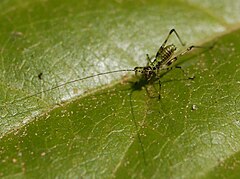
Insects in the family Tettigoniidae are commonly called katydids or bush crickets. They have previously been known as "long-horned grasshoppers". More than 8,000 species are known. Part of the suborder Ensifera, the Tettigoniidae are the only extant (living) family in the superfamily Tettigonioidea.

Orthoptera is an order of insects that comprises the grasshoppers, locusts, and crickets, including closely related insects, such as the bush crickets or katydids and wētā. The order is subdivided into two suborders: Caelifera – grasshoppers, locusts, and close relatives; and Ensifera – crickets and close relatives.

The speckled bush-cricket is a flightless species of bush-cricket belonging to the family Tettigoniidae. The species was originally described as Locusta punctatissima in 1792.

Saga pedo is a species of wingless bush cricket from the southern half of Europe and western and central Asia. This brown or green bush cricket typically has a total length, from the head to the tip of the ovipositor, of up to 10.5 cm (4.1 in), but exceptionally it may reach 12 cm (4.7 in), which makes it one of the largest European insects and one of the world's largest Orthoptera. The head-and-body alone typically is 5–7 cm (2.0–2.8 in) long in adults, but may reach up to 7.8 cm (3.1 in).

Crickets are orthopteran insects which are related to bush crickets, and, more distantly, to grasshoppers. In older literature, such as Imms, "crickets" were placed at the family level, but contemporary authorities including Otte now place them in the superfamily Grylloidea. The word has been used in combination to describe more distantly related taxa in the suborder Ensifera, such as king crickets and mole crickets.
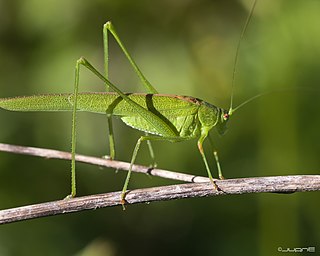
Phaneroptera is an Old World genus of bush crickets in the family Tettigoniidae and is the type genus of the subfamily Phaneropterinae. It was described by Jean Guillaume Audinet-Serville in 1831 and species are recorded from Europe, Africa and Asia.

Metaplastes pulchripennis, common name Italian ornate bush-cricket, is a species of 'katydids crickets' belonging to the family Tettigoniidae subfamily Phaneropterinae.
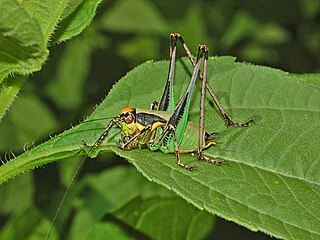
Eupholidoptera chabrieri is a species of katydid belonging to the subfamily Tettigoniinae.

Tettigonia cantans is a species of bush crickets belonging to the family Tettigoniidae subfamily Tettigoniinae.

Yersinella raymondii, common name Raymond's bush-cricket, is a species of "katydids crickets" belonging to the family Tettigoniidae subfamily Tettigoniinae. The scientific name Yersinella comes from the name of the entomologist who has described the species in 1860.
Panoploscelis is a genus of very large insects belonging to the true katydid tribe Eucocconotini, which is a subfamily of the Tettigoniidae. Like the other members of the suborder Ensifera, Panoploscelis are part of the insect order Orthoptera, which also contains crickets, grasshoppers and locusts. Members of this genus are among the largest katydids of the Neotropics.

Barbitistes obtusus, the southern saw-tailed bush-cricket or Alpine saw bush-cricket, is a species of bush crickets in the subfamily Phaneropterinae.

Tegra novaehollandiae is a species of bush crickets in the tribe Cymatomerini and the subfamily Pseudophyllinae; it is native to tropical Asia.

Phaneroptera falcata, the sickle-bearing bush-cricket, is a species of Orthopterans belonging to the subfamily Phaneropterinae. It is mostly herbivorous and commonly measures 24 to 36 mm long. It lives mainly in warm scrub and grasslands areas, also on dry shrubbery and in sand pits and gardens.
Gryllus integer, commonly known as the western trilling cricket, is one of many species of field cricket in the genus Gryllus. It is called the "triller" field cricket because its song is nearly continuous rather than broken into discrete chirps. G. integer can be found in parts of the Western United States, having been recorded from Oregon, California, Arizona and New Mexico.
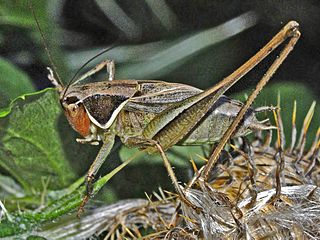
Sepiana sepium, common name sepia bush-cricket, is a species of bush crickets belonging to the tribe Platycleidini and genus group Platycleis. It is the only species within the monotypic genus Sepiana.
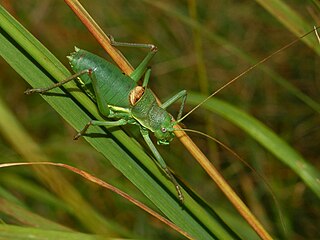
Ephippiger perforatus, the North Apennine saddle bush-cricket, is a species of insect in the family Tettigoniidae.
Metaplastes ornatus is a species of bush cricket in the family Tettigoniidae.

Caedicia simplex is a species of bush cricket or katydid, native to New Zealand and Australia. A common name is the "common garden katydid".
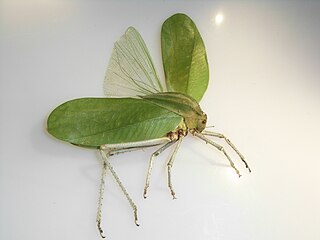
Siliquofera is a genus of bush cricket in the subfamily Phyllophorinae that includes only one species, Siliquofera grandis, which is fairly common and widespread in rainforest canopies of New Guinea and nearby smaller islands, and seemingly rare in Australia where only found in the remote Iron Range region. This very well-camouflaged, green and leaf-like bush cricket is one of the world's largest Orthoptera, with adults typically having a length of 10.7–13 cm (4.2–5.1 in) and a wingspan of 25–27 cm (9.8–10.6 in); it can weigh more than 30 g (1.1 oz).


